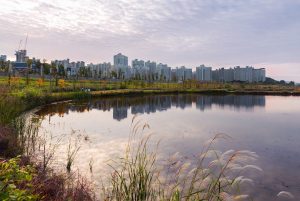Announced ahead of this year’s general elections, South Korean President Moon Jae-in’s Green New Deal seemed to strike the right chord. With its plan lauded as the first Green New Deal in East Asia, the ruling Democratic Party showed that ethical leadership is still possible in the era of climate-change denying strongmen.
This, however, is not South Korea’s first ambitious environmental plan, and as in the past corporate interests seem to be overshadowing those of the environment. The government once again risks locking the country into decade-long projects that may prove to be environmentally and economically unsustainable.
The last such attempt was the 2008 National Green Growth Strategy of President Lee Myung-bak. A centerpiece of Lee’s strategy was the Four Rivers Project, a 31 trillion won ($27.6 billion) “river restoration” and damming scheme, which quickly proved an environmental disaster. South Korea’s current government is now removing several of the dams, at a cost of nearly 90 billion won ($75 million).
Lee also promoted the decade-long Clean Diesel Policy. This foray into pro-green politics resulted in billions of taxpayers’ won wasted on subsidies, worsening air quality, and 10 million diesel vehicles that future governments have to get off the road.
In Moon’s Green New Deal, electricity supply is of central concern. Much attention has been paid to the government’s stated goal of 30-35 percent renewable energy by 2040, but this will be accompanied by an increasing reliance on LNG, as coal plants are replaced.
At the point of use, LNG produces far less greenhouse gases and air pollution than coal. But through the production process large amounts of methane — a greenhouse gas 25 times more potent than carbon dioxide – is released into the air. Moon’s attempt to turn South Korea from climate villain to role model may end up buying gains in domestic air quality at the cost of long-term environmental losses.
The government will argue that given concerns of pricing and supply, they have no option but to shift the country to LNG. What this really means is that in Moon’s South Korea it is business as usual — cheap electricity for heavy industry behemoths.
Financially, South Korea risks sinking billions into gas plants that future governments will need to prematurely shutter if they hope to meet not only the target of the Paris Agreement to limit global warming to 2 degrees Celsius, but also the 2050 target for net-zero emissions set by Moon’s own party (although this pledge is now being watered down). The stranded asset risk under this scenario stands at $60 billion, according to a recent report by the financial think tank Carbon Tracker.
Another arrow in South Korea’s climate quiver is hydrogen fuel cell electric vehicles (FCEV). Current state subsidies for FCEVs are up to 3 times greater than those for battery electric vehicles, and Moon himself chose an FCEV as his official vehicle, referring to the vehicles as “running air purifiers.” The problem is that at least for the foreseeable future, South Korea’s hydrogen will remain gray, not green, as it will be produced from fossil fuels.
Compared to battery electric vehicles, which charge off the power grid, hydrogen for FCEVs has to be produced, frozen, transported, and then converted back into electricity in the car; a process that loses up to 70 percent of the original energy. This calculation was behind Volkswagen’s decision to publicly abandon passenger FCEVs last year. Mercedes-Benz followed suit this April.
As with the Four Rivers Project, it will be South Korean conglomerates that will build this new hydrogen infrastructure. And as with the Clean Diesel Policy, they will also gain a captive market for their vehicles and fueling services. But it remains far from clear whether this is environmentally, or even economically, the best investment for the future.
Both LNG and hydrogen plans are premised on South Korea’s existing commitment under the Paris Agreement to reduce emissions to 37 percent of business-as-usual (BAU) levels by 2030. Not everyone, however, is convinced this is enough. A recent report by climate change institute Climate Analytics criticized these targets, and reiterated that they are “highly insufficient.” The Berlin-based institute says South Korea should be aiming higher, setting emission reduction targets at least 74 percent below BAU levels if it plans to meet long-term temperature goals. In other words, if the rest of the world were to follow South Korea’s current lead, we would be facing global temperature rises of 3 to 4 degrees C.
As the Moon administration works to dismantle sections of the Four Rivers Project and remove diesel vehicles from the road, it would be a shame if future governments are themselves lumbered with redundant LNG power plants and underutilized hydrogen infrastructure. History is said to repeat itself, but in the face of the looming climate crisis, we really don’t have time for that.
Sam Macdonald is the International Solidarity Coordinator for the Korean Federation for Environmental Movements, South Korea’s largest environmental NGO. He is also a translator and communications assistant for Climate Crisis Emergency Action, a network of 190 groups advocating for climate action in Korea.

































